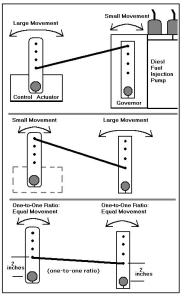Remember these important ratios that make or break your boat’s handling.
1-Ratio Of Steering Cylinder-To Rudder Arm Travel: When steering components are changed or a new boat is built, the steering helm can require too many turns to steer the rudder from lock-to-lock to be practical. This will also greatly reduce the steering effort. Or, if the system has insufficient turns, the effort required at the helm can be far too high to be practical.
To remedy these conditions, move the point of connection to the rudder arm out if the effort is too high. If on the other hand the system requires too many turns, move the point of connection inward toward the rudder shaft, even drilling an additional hole if needed.
- 2-Ratio Of Transmission Output Speed-To Engine Speed: When a diesel engine turns at 2,000 rpm and the propeller shaft turns at only 1,000 rpm, it is said that the drive ratio through the transmission of 2:1. Put another way, 2,000 rpm is going into the front of the transmission but only 1,000 rpm comes out the back. This is accomplished by using two gears inside the transmission running together. From the ratio we can see that the driving gear, the one from the engine, must have half the number of teeth than those on the gear that drives the propeller shaft. The gear reduction is what allows the engine, transmission, and propeller shaft to work together to move the boat efficiently through the water.
- 3-Ratio Of Governor Lever-To Throttle Control Movement: The response of engine speed acceleration can be changed by altering the ratio of the control-to the throttle lever movement, as shown.
4-Ratio Of Transmission Shift Valve-To Travel Of Shift Control Movement: The same is true for the shifting mechanism.
![]()
![]()
(Some of this material excerpted from “PRACTICAL BOAT MECHANICS”, by Ben L. Evridge, to be published this fall.)



Recent Comments